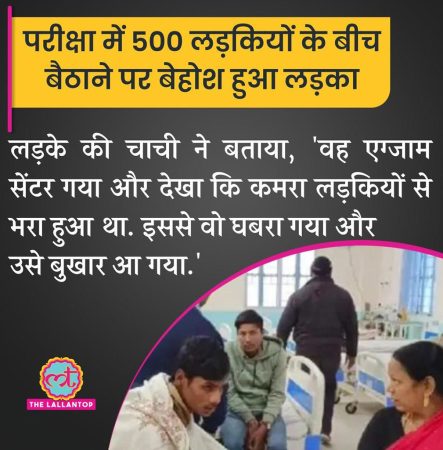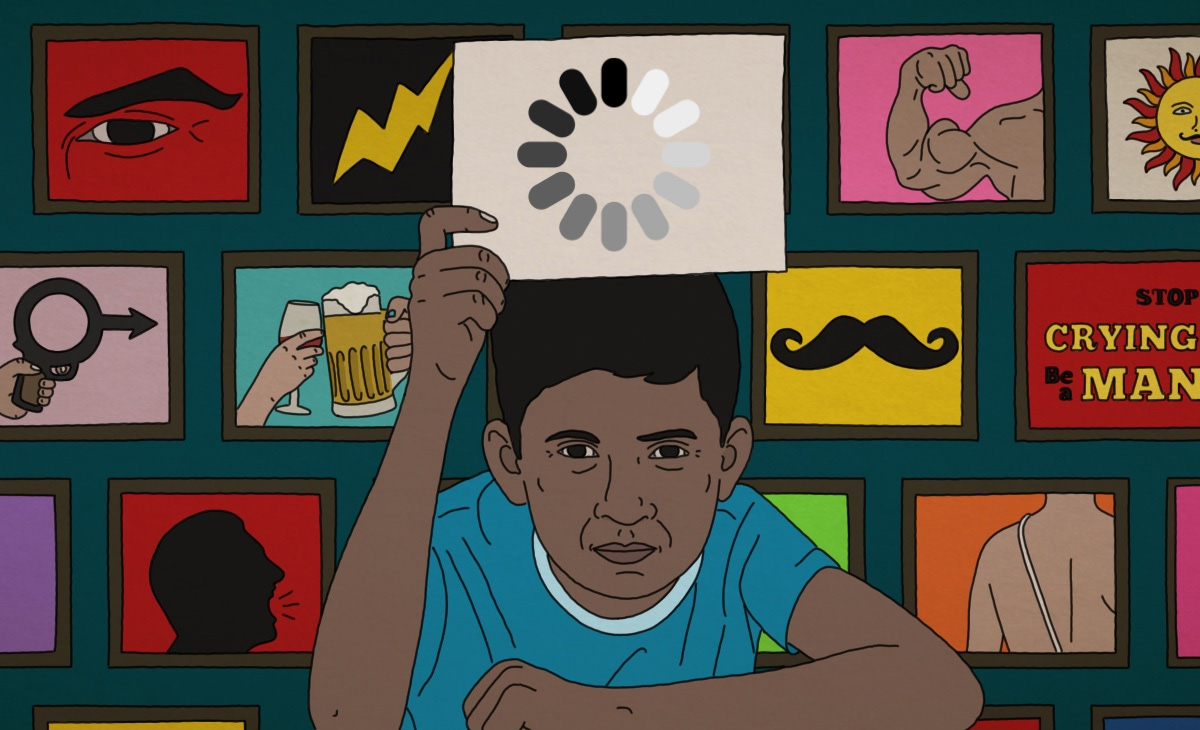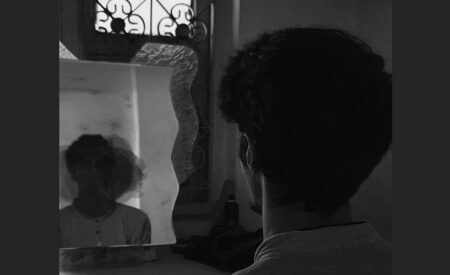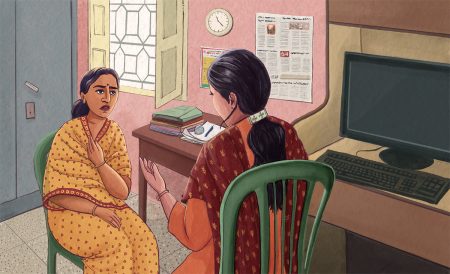The graphic below is in Hindi. The translation reads:
Being seated amongst 500 girls, boy faints during exam. The boy’s aunt explained, “At the exam centre, when he saw that the room was crowded with girls, he became anxious and caught a fever.”

Many of my friends laughed (albeit nervously) reading this news about a 17-year-old in Bihar. Digging further, one finds that apparently, the boy’s admit card labelled him female due to either a printing or human error, thus assigning him an examination centre where all other students were girls. When he showed up there, he was questioned about the error, causing his breakdown. At the end of a short video where the boy’s aunt is explaining what happened, she smiles. Someone, who seems to be the boy’s male guardian, was also smiling right before patting his back reassuringly.
The only person not smiling in the now-viral video is the boy, felled by fever and weakness that made many girls cackle.
Work on gender in the development and social sector has traditionally engaged with women and girls. It was only in the mid-90s that some NGOs started working with men and boys on issues of gender. One of the first entry points for this was population control and reproductive health where they were encouraged to use condoms and to accompany their pregnant wives to healthcare centres. The objective was to involve men in women’s reproductive health programmes in the form of gender sensitisation workshops. Soon, the objective also became preventing violence against women, especially wife-beating. By the first decade of the 2000s, many global spaces such as Men Engage had become active in South Asia, with Forum to Engage Men (FEM) emerging at the national level. It is very recently that the work with men and boys on gender has started looking at masculinity and taken a broader view of violence beyond gender-based violence.
What to do with men in feminist work? This is the question some educators in the development sector have been asking themselves and struggling to answer. For the longest time, men were purely in the category of challenge—those who had to be deterred from drinking, gambling, beating their wives and shouting at their children.
Then, in the mid-90s, the development sector started looking at men as stakeholders who should not be kept away but instead be brought in to make the work with women easier and more sustainable. One example of this is reproductive health programmes where men were encouraged to use condoms, and accompany their pregnant wives to the maternity clinic regularly. It’s only as recently as the end of the 2000s that the sector has programmatically started looking at men and boys as participants or even allies in the feminist movement. From this recent work, engagement and pedagogy, emerges a diagnosis often termed the ‘crisis of masculinity’.
We asked trainers working with boys and/or on masculinity(ies): what are they dealing with? What are they learning about masculinity from their field experiences? How does feminist pedagogy adapt to deal with men and masculinity(ies)? When you enter a room full of boys, hoping to unpack either gender or sexuality or masculinity(ies), what do you instead end up unpacking, both for yourself and for them?
We spoke to 11 people, facilitators, trainers, filmmakers, theorists and academicians, to help us mark the multiple ways men are feeling their way around in a new world where women have changed. What emerges is a revelation of the messiness of working with gender, when the gender in question carries power.
The crisis of masculinity is understood; the crisis of the trainer working with masculinities is not.
Why let go of power?
Manak Matiyani, former executive director of the YP Foundation, brought in the masculinity agenda to YP with the question, “How can gender programmes speak to men without completely alienating them…” With a glint in his eye, he added, “…while being conscious of not reinforcing their privilege?”
And that is the first crisis, because unlike workshops with young women that carry affirming messages about agency and empowerment, the sessions with young boys tend to be punitive and, as Manak said, “the opposite of affirming”, almost as if the boys have been held for detention and now they will be told what they did wrong. So, why would boys even want to be in a space like this?
“The million-dollar question remains that what is it (learning about gender) going to give me per se, in return, because one thing we all have to grapple with is that men will have to undo privilege… if I give away my privileges that I’ve been enjoying for years, what am I to get in return? What are the personal gains which I get?” says Harish Sadani, secretary and chief functionary of Men Against Violence and Abuse (MAVA), based in Mumbai.
Abhijit Das, Managing Trustee of the Centre for Health and Social Justice (CHSJ), with the experience of three decades of public health interventions into masculinity, argues that gender equality cannot be the only objective of masculinity advocacy. First, he points out that unlike the majority of work with women which often only looks at marginalisation, the work with men is always about working with privilege. Development sector programmes on masculinity tend to be purely poverty-based, dealing with men in rural areas and/or from marginal caste/class locations, so while these men have the privilege of gender, they find themselves suffering daily due to caste and/or class oppression. (It would be different if development sector programmes were working with savarna, upper-class, cis-het men, but that has its own set of challenges.) Thus, there is always a layer of subordination in operation along with privilege. He argues, “Not just masculinity, but for work on any equality, you have to understand privilege because equality cannot be the sole interest of any subordinate group. Historically, subordinate social groups have called for equality. But, if equality is a social aspiration of only the subordinate group, then where is equality?”
But if boys are purely expected to let go of power, then…
…why would boys even enter the room?
As Manak argues, “The kind of real reward… of doing patriarchal masculine performance… does exist. How do I go about telling boys ki bhai, don’t give into this kind of pressure [and resist the rewards]?” Akshat Singhal, the co-founder of Gender Lab, says, “It’s so easy and comforting to fall back into the existing structures for us as men. It’s easier for us to not question and chup chaap karte raho because it’s working. Because the moment I get boys to question their own power and privilege, unko apne aap par kaam karna padega, uska alag cost hai. Inner work does not come so easily. They are somewhere also having to lose what they are getting virasat mein.”
But, is the existing structure working perfectly for men and boys? “I felt lonely and distressed at the time,” says Harish Sadani as he recounts his school days when he was teased and taunted for being “sissy and girlish”. There is the loneliness of the transgressive men (cis-het or not) and there is the loneliness of the hypermasculine men who are unable to foster meaningful relationships. While feminist advocacy offers women collectives, friendships and solidarities, loneliness is one of the most common experiences of young men in this country. We know this not only according to all our interviews with trainers, but also from Yuvaa’s extensive surveys with the youth from 100 college campuses across 50 Indian cities. (This study was presented by Yuvaa in the Build Together: Gender and Masculinities conference organised by Rohini Nilekani Philanthropies in Mumbai in 2022.)
Nikhil Taneja, CEO and co-founder of Yuvaa, says, “Why is it that the only emotion that a maximum number of boys express is love for girls? Because that’s the only expression of emotion they’re allowed. They keep talking about love and heartbreak because this is their only entry point into sadness.” Heartbreak is the common guise under which men can unite.
Manak explains the theoretical basis of work on masculinity, inspired by Australian sociologist R.W. Connell’s theory of hegemonic masculinity.
“Masculinity is seen as access to power whereas it actually is the expectation of power. It is the expectation that you must always be powerful… The experience of masculinity is that I’m actually not!”
Trainers find many, many ways of entering conversations around gender and masculinity—such as sexual and reproductive health, sexuality, romance, and in some cases, the popular idea of masculinity itself. In one of Manak’s sessions, the entry point was the question, “What do you think is ‘cool’ and do you think you are cool as a person?” Without mentioning gender or masculinity, this automatically opened up insecurities with regard to masculinity. Manak calls this an exploration of self-image—looking inwards before heading outwards.
He narrates the response to the programme Mardon Waali Baat, “The first poster we put out in a college with “Mardaangi kya hoti hai?” with a question mark and Superman ki photo on it, and all these boys came because they wanted an answer! They were like, “Yeah, we want to know ki mardaangi kya hoti hai so that we can do it well.”
As someone who has been in both the education and entertainment sectors, Nikhil knows that humour goes a long way in disarming people. “I start with an entertaining story and bring them into the conversation where they don’t feel that this is a person who has come to preach, bore us, or even challenge us…’” As soon as they are engaged, he introduces a certain level of vulnerability, like bringing up an anecdote about a panic attack. According to Nikhil, you must respect the boys enough to be vulnerable with them if you want them to be open to you. “I believe that stories lead to more stories and vulnerability leads to more vulnerability.”
In 2021, Dr. Ketaki Chowkhani did a research study with middle-class and upper-class heterosexual boys in Mumbai, asking them about their experiences of adolescent romance and sources of information on the matter. One of the biggest findings was that indeterminacy, that is lack of definition, and ‘failure’ in romance are very common experiences of adolescent boys and such events rarely lead to violence, however serious the relationships might have been. She writes, “This whole idea of the predatory male completely changed. I realised that they had far more fear and far more care. Our starting point is normally violence but what if the starting point is vulnerability? If we normalise failure, indeterminacy, vulnerability and hesitation instead of violence, what happens to gender relations?” In her experience of conducting this research, she also felt the space of research slowly becoming one of “therapy”. “They thought I was a psychologist and saw it almost as a ‘therapeutic space’… ” This space allowed them to open up about the romantic failures and rejections they faced in their adolescence, which popular images and perceptions of hegemonic masculinity rarely acknowledge.
And that is how the facilitators countered the first crisis. That is how they got boys into the room, with the promise that their stories would be heard the only way they should be in a pedagogical space—without any judgement. But this leads to a deeper crisis.
In the next part, we ask the critical question: is catharsis, listening and sharing enough for men to reflect on masculinity?
Read Part 2 here.
(With inputs from Nirantar Trust’s Learning Resource Center)





